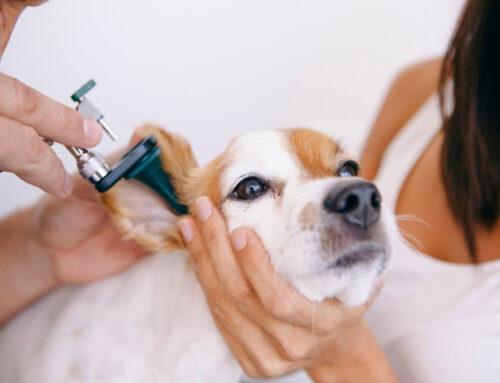Clearer Answers Through Advanced Ear Diagnostics for Pets
A dog who won’t stop shaking their head or a cat pawing at one ear can leave pet owners guessing about the underlying issue. Is it mites, an infection, or something more serious?
Ear issues are notoriously tricky. Without the right tools, the root cause can remain hidden. Advanced diagnostics such as CT scans, endoscopy, and specialized imaging can reveal what’s really going on, guiding the best treatment.
At Cupertino Animal Hospital in Cupertino, CA, our investment in technology and ear specialty care means faster relief, fewer repeat visits, and peace of mind for both pets and their families.
Common Causes of Ear Issues in Pets
Potential causes of ear issues in pets are diverse.
- Heavy, floppy ears create a warm, moist environment where bacteria and yeast thrive.
- Ear mites, especially in younger pets, cause intense itching and dark, coffee-ground-like discharge.
- Bacterial and fungal infections can occur independently or as secondary issues.
- Foreign objects such as grass awns or debris can lodge in the ear canal, causing pain and complications if untreated.
What Is Otitis?
“Otitis” simply means inflammation of the ear, but in pets, it can affect different parts of the ear canal- each with its own challenges and implications for treatment. Understanding which section of the ear is involved is essential for accurate diagnosis and effective care.
Otitis externa affects the external ear canal and is by far the most common form seen in dogs and cats. It may start as mild irritation or redness but can quickly progress to painful swelling, discharge, and chronic infection if not addressed early. Repeated inflammation can cause permanent narrowing of the canal, making pets more prone to recurrence.
Otitis media involves the middle ear, located just behind the eardrum. This deeper infection can occur when bacteria or yeast spread inward from a chronic external infection, or less commonly, through the bloodstream or a ruptured eardrum. Pets with otitis media may show head tilting, pain when opening the mouth, or balance issues.
Otitis interna affects the inner ear- the structure responsible for hearing and balance. This is a more serious condition that can cause neurological signs such as head tilt, nystagmus (rapid eye movement), and loss of coordination. Inner ear infections can result in permanent hearing loss or severe discomfort if not treated promptly.
Because ear anatomy is intricate and problems in one area often spread to another, advanced diagnostics such as ear imaging and endoscopy are critical. If left untreated, ear disease in pets can lead to chronic inflammation, scarring, narrowing of the canal, or involvement of deeper ear structures that jeopardize hearing and may ultimately require surgery.
Using Advanced Diagnostics to Treat Ear Issues in Pets
Traditional exams are valuable but can’t always visualize the complete ear. Advanced imaging fills those gaps and improves diagnostic accuracy and treatment planning.
- CT scans provide detailed cross-sectional views of the ear, revealing soft tissues, fluid, and subtle structural ear changes that X-rays may miss. At Cupertino Animal Hospital, CT imaging is used not only for diagnosis but also for tracking treatment progress, identifying hidden middle ear infections, or locating growths that would otherwise remain unseen. This 3D insight allows veterinarians to map out surgical or medical approaches with precision.
- Small animal X-ray diagnostic imaging is helpful for initial bone assessment, while CT becomes invaluable for complex cases and surgical planning. X-rays can quickly confirm bony changes or mineralization patterns within the ear canal that may indicate long-standing inflammation or tumors.
- Small animal ultrasound diagnostic imaging adds non-invasive insight into soft tissue and fluid patterns within ear-adjacent spaces, informing treatment without discomfort. When combined with CT or endoscopy, ultrasound provides a dynamic, real-time look at fluid movement, abscesses, or structural asymmetries that may contribute to chronic disease.
Advanced imaging doesn’t just identify disease- it helps quantify its severity, visualize hidden infection pockets, and guide interventions such as myringotomies (eardrum punctures for middle ear sampling) or surgical planning. This technology-driven approach transforms ear care from symptom-based treatment to true, evidence-based medicine.
Pet Ear Endoscopy: Providing a Closer Look
Endoscopy lets veterinarians directly visualize the ear canal and eardrum with exceptional clarity using a thin, camera-equipped scope. This minimally invasive approach is typically performed under sedation or anesthesia for your pet’s comfort and for exam thoroughness.
Beyond visualization, endoscopy enables:
- Precise removal of foreign objects like grass awns
- Targeted sampling for lab testing
- Thorough cleaning and flushing of infected areas
Endoscopy’s diagnostic value extends beyond simple inspection- it provides real-time assessment of tissue health, identifies microtears or perforations in the eardrum, and reveals hidden lesions or polyps that traditional otoscopy can miss. Video endoscopy also allows for recorded imaging, which helps track response to treatment and improves client communication through visual evidence of disease progression and healing.
Endoscopic procedures have transformed ear diagnostics and treatment by offering complete, real-time views that traditional otoscopes can’t match.
At the Pet Ear Care Center at Cupertino Animal Hospital, endoscopy is integrated into comprehensive ear evaluations. This approach is especially valuable for chronic ear cases, failed previous treatments, or unusual symptoms suggesting complex disease. Combining endoscopic visualization, cytologic sampling, and advanced imaging ensures nothing is overlooked.
Advanced Techniques in Ear Diagnostics

When it comes to diagnosing chronic or complex ear conditions in pets, precision matters. Our clinic’s advanced techniques like cytology, culture, and biopsy allow our team to move beyond surface symptoms and uncover the underlying causes of your pet’s ear condition. Each diagnostic test provides a different layer of insight- from microscopic cellular detail to molecular-level data about infection resistance- allowing for a comprehensive understanding of ear health.
Cytology, Culture, and Biopsy: Getting to the Root of Pet Ear Conditions
Identifying the organisms or cellular changes behind ear problems often starts with cytology, which is a microscopic evaluation of cells and debris collected from the ear. Cytology provides immediate information about bacteria, yeast, and inflammatory cells, allowing veterinarians to identify whether an infection is bacterial, fungal, or inflammatory in nature before initiating targeted therapy.
Veterinary ear cytology is essential for selecting the right treatment for an animal’s ear condition. This quick, in-house test distinguishes bacterial infections, yeast overgrowth, and inflammatory conditions, supporting targeted therapy rather than broad-spectrum approaches that may be ineffective. Cytology is often repeated throughout treatment to monitor improvement and adjust medication when needed, ensuring faster resolution.
Culture and sensitivity identifies the specific bacteria or fungi causing an ear infection and determines which medications will be most effective. This is especially important for chronic or complex ear cases, where infections often involve resistant organisms or mixed microbial populations. In these situations, empirical treatments may fail because pathogens have adapted to previous medications or formed biofilms that protect them from standard therapy. Advanced culture techniques can also quantify bacterial load and detect multi-drug resistance, allowing for more strategic, long-term care plans.
By revealing the exact microbes and their drug sensitivities, culture testing allows veterinarians to choose the most targeted, effective treatment. This prevents repeated courses of ineffective medication, limits antibiotic resistance, and helps pets recover more quickly. For recurring or deep-seated ear infections, culture results also guide long-term management, ensuring a more precise and compassionate approach to care.
A biopsy may be recommended when test results indicate more complex disease. Obtaining a sample for biopsy includes removing a small amount of tissue, not just a collection of cells like with cytology, and provides cellular details to help our team identify:
- Tumors
- Unusual inflammatory conditions
- Structural changes needing specific therapies
Biopsy results are especially important when chronic inflammation leads to tissue thickening or when cancer or immune-mediated disease is suspected. This in-depth tissue analysis provides a definitive diagnosis, enabling customized treatment plans that may include surgery, immunotherapy, or advanced medications.
Oftentimes, cytology, culture, and biopsy complement each other. Cytology offers rapid cellular insights, culture targets specific organisms, while biopsy details tissue architecture when a definitive diagnosis is needed. Together, they create a layered diagnostic approach that uncovers every factor contributing to a pet’s ear problem.
Surgical Interventions for Pet Ear Disease
Some ear conditions need surgery for full resolution. Our surgical services include procedures from ear canal cleaning under anesthesia to reconstructive surgeries for chronic disease unresponsive to medical therapy.
Advanced imaging guides surgical planning, providing detailed anatomy for safer procedures and better outcomes.
Partner With Your Veterinary Team
Maintaining a consistent relationship with your veterinarian helps establish your pet’s baseline ear health, making changes easier to spot. Share details about your pet’s behavior, environment, grooming, swimming habits, and any prior ear history to help tailor prevention and treatment.
Getting the Right Answers for Your Pet
Advanced ear diagnostics turn guesswork into precise, targeted treatment plans that address the root cause of discomfort. Our comprehensive capabilities provide the detail needed to treat pet ear conditions effectively and prevent recurrence.
If your pet is showing signs of ear discomfort, call Cupertino Animal Hospital at (408) 252-6380 or contact us to schedule an evaluation. Our team is ready to provide the advanced care your pet needs for lasting ear health and comfort.















Leave A Comment